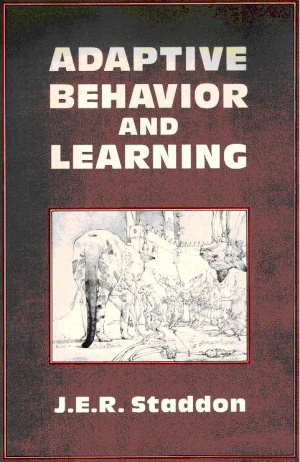Difference between revisions of "Adaptive Behavior and Learning"
Jump to navigation
Jump to search
m (→Contents: formatting; titles for chapters 1, 2) |
|||
| Line 2: | Line 2: | ||
''Adaptive Behavior and Learning'' | ''Adaptive Behavior and Learning'' | ||
by J.E.R. Staddon | by J.E.R. Staddon | ||
==Contents== | ==Contents (2003 Internet Edition== | ||
*[[Adaptive Behavior and Learning: Title Page| Title Page]] | *[[Adaptive Behavior and Learning: Title Page| Title Page]] | ||
*[[Adaptive Behavior and Learning: Preface| Preface]] | *[[Adaptive Behavior and Learning: Preface| Preface]] | ||
Revision as of 12:07, 18 May 2006
Adaptive Behavior and Learning by J.E.R. Staddon
Contents (2003 Internet Edition
- Title Page
- Preface
- Chapter 1 PDF: The Evolution, Development, and Modification of Behavior
- Niches, similarities and differences
- Philosophical background
- Evolution and development
- Chapter 2 PDF: Variation and Selection of Behavior
- Simple orientation mechanisms
- Reflex mechanisms
- Inhibition and reflex strength
- Chapter 3 PDF
- Taxes
- The integration of behavior
- The nature of explanation
- Chapter 4 PDF
- Causal and functional analysis of operant behavior
- The logic of historical systems
- Chapter 5 PDF
- Reinforcement and the law of effect
- Contingency and feedback functions
- Chapter 6 PDF
- Reinforcement and homeostasis
- Obesity and schedule performance: a static analysis
- Chapter 7 PDF
- Utility and adaptation to constraint
- The allocation of behavior
- Experimental applications
- Chapter 8 PDF
- Optimal choice
- Matching and maximizing
- Overall maximizing
- Chapter 9 PDF
- Diet selection and functional response
- Natural feedback functions
- Chapter 10 PDF
- The definition of stimulus
- Stimulus generalization
- Similarity
- Chapter 11 PDF
- Inhibitory and excitatory' control
- Behavioral contrast and discrimination performance
- Competition and matching
- Chapter 12 PDF
- Time-allocation constraints: the pressure model
- Chapter 13 PDF
- Temporal control
- Memory and spatial learning
- Chapter 14 PDF
- Template learning
- Reinforced learning
- Chapter 15 PDF
- Historical background: operant and respondent behavior
- Behavioral variation: the origins of operant behavior
- The guidance of action
- Experimental applications
- Chapter 16 PDF
- Conditioned reinforcement
- Avoidance and escape
- Extinction
- References
